The Proposal - Component 1 - The Education of Our Sons
A Look at the Educational State of Boys
Prepared by Members of the Coalition to Create a White House Council on Boys & Men

From the editor: In the report that follows, the majority of data comprised includes statistics about the challenges boys face in our current educational systems. Although our primary focus is boys, members involved in this research equally understand the challenges girls face and the different needs they require to succeed. The more we look at nature, nurture, and culture the more we are able to help our boys and girls find success. This proposal is a means of providing educational leaders, teachers, parents, legislatures, politicians, and community groups with an understanding of the current trends for boys and young men and the need to reshape the way we mentor, guide, and teach them.
Contents
Executive Summary
Part A: College Success and What it Tell Us
A.1 When Girls Go To The Altar
Part B: What is Happening in our K-12 System?
B.1 Romeo and Juliet Saved My Life
Part C: The Social Consequences of the Under-Educated
Part D: Education and Gender
Part E: Finding Solutions
Part F: Essential Readings for Educators & Policy Makers
Part G: End Notes
Executive Summary
Our coalition of leading researchers believes students deserve 100% of our nation’s efforts. We need to focus on individual students and their unique learning needs, and this success can only happen if we replace outdated practices and implement new and proven practices. Boys continue to lose ground in education, yet we do little to alleviate the serious problems for our nation’s sons.
 Boys have fallen behind in conferred Associate, Bachelor, Master, and Doctoral degrees by significant margins and show a significant decrease in the number of AP exams taken each year. In 2016, females accounted for 56% of all students taking AP exams and, interestingly, females accounted for 57% of Bachelor’s degrees.96,2 College success is only one of many measures that underlines the struggles boys are having in K-12, college, career, and life.
Boys have fallen behind in conferred Associate, Bachelor, Master, and Doctoral degrees by significant margins and show a significant decrease in the number of AP exams taken each year. In 2016, females accounted for 56% of all students taking AP exams and, interestingly, females accounted for 57% of Bachelor’s degrees.96,2 College success is only one of many measures that underlines the struggles boys are having in K-12, college, career, and life.
We must recognize that boys learn differently, and they need new approaches and many options to a variety of career paths. As it currently stands, boy are struggling in ways that must change.
Boys account for:
• Two thirds of the grades of D and F given out in American schools
• The majority of high-school dropouts
• The largest gender gap in our schools—the literacy gap
• More than 80 percent of discipline referrals
• Suspensions and expulsions at five times the rates for girls
Boys also account for the following:
 • By age 12, boys are 60 percent more likely than girls to have repeated at least one grade.
• By age 12, boys are 60 percent more likely than girls to have repeated at least one grade.
• Boys have an 82 percent greater risk of developing learning disabilities by comparison with girls.
• Only half as many boys as girls are members of the National Honor Society
• Boys are much less likely than girls to participate in student government, academic clubs, student clubs, and the performing arts.
African-American Youth is Particularly at Risk for Educational Deficiencies and Failures:
• African-American boys are only half as likely to be in college as African-American girls.
• The African-American boy who drops out of high school has a 72 percent chance of being jobless by the time he reaches his 20s.
• By his mid-30s, the African-American boy who drops out of high school has a 60 percent chance of having spent time in prison.
Our coalition views education as a top priority for America’s boys. Not only is education of overwhelming importance to an informed American public, but it is important to later life success for boys and girls.
Accordingly, our coalition asks the U.S. Department of Education to take a leading role in restoring educational opportunities and services to our sons. In particular, the Department can implement the following:
• Fund and support the hiring of more male teachers, particularly at the elementary and middle-school levels
• Balance Department of Education Gender Equity Reports to serve both boys and girls
• Investigate single-sex schools and single-sex class options to address the better address the learning differences of boys and girls
• Update teacher-training programs to build an awareness to the different ways boys
and girls learn in the classroom
• Develop boy-friendly reading and language programs
• Develop and employ evidence-based educational practices
Beyond these near-term steps, the Coalition hopes that the U.S. Secretary of Education will work to create, within the Department, a home for advocacy on behalf of America’s boys— perhaps a USDoE Council on Boys and even consider a White House Council on Boys and Men stationed in the Department of Education
Fewer than 10% of elementary school teachers are male.
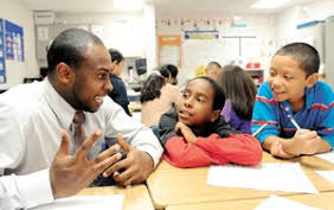 Recognizing social challenges impacting our classrooms and schools is important. With increased divorced rates and the number of children born out of two parent families, fewer boys and girls interact with fathers on a regular basis. Boys and girls will benefit from more male teachers.
Recognizing social challenges impacting our classrooms and schools is important. With increased divorced rates and the number of children born out of two parent families, fewer boys and girls interact with fathers on a regular basis. Boys and girls will benefit from more male teachers.
Part A: College Success and What It Tell Us
It’s increasingly clear that boys are struggling to find academic success equivalent to their female peers. As the economy becomes more global, education is increasingly becoming more essential and conferred college degrees (from associates degrees to doctoral degrees) provide some insight into the ways our boys are being prepared. (It’s one of the reasons a number of national experts continue to advocate for a White House Council on Boys and 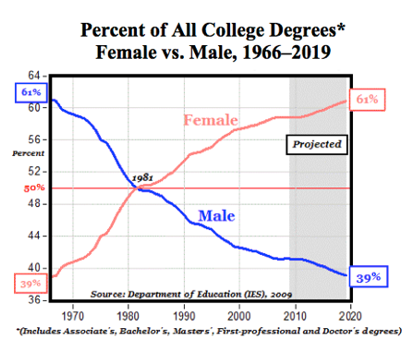 Men as a way to address the challenges boys face in today’s educational system.) By recognizing the current educational state of boys, we can address the reasons for their lack of success and implement progressive solutions that require strong leadership.
Men as a way to address the challenges boys face in today’s educational system.) By recognizing the current educational state of boys, we can address the reasons for their lack of success and implement progressive solutions that require strong leadership.
Several years ago leading experts included the above 2009 data6 as part of a review of the current state of boys in education. The trend showed women have surpassed and will continue to surpass men in conferred degrees. 2012 data from the National Center for Educational Statistics2 revealed more detailed and concerning trends. Women have surpassed men in all areas of conferred degrees.32,33,34
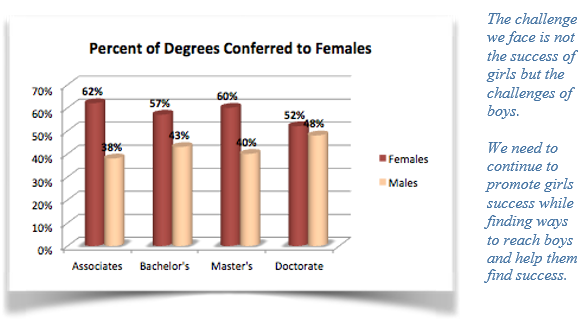
Female college enrollees and female college graduates 2,20,21 now far outnumber their male counterparts—a trend that shows no sign of leveling off when one looks at the current data and the projected data supplied by the National Center for Educational Statistics.2 Conferred, college degrees provide us with some insight into the ways our K-12 programs fail to prepare boys for future success. We must look at the performance of boys and girls in school and employ evidence based practices and strategies that work equally hard to help boys become teachers and girls become engineers.
A.1 When Girls Go To The Altar

Part B: What is Happening in our K-12 System?
What is happening in our K-12 schools that make college preparation a greater challenge for boys? The snapshot below from Gurian’s Saving our Sons93 gives us a context.
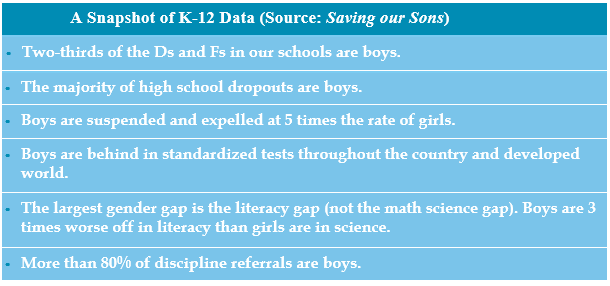
 When we look at the snapshot above, we cannot help but notice the suspension and discipline data. Suspension and discipline data help us further understand that our system struggles to engage and direct boys to academic success and instead sends them to principles offices, medication, and violence. The number of boys who said they didn’t like
When we look at the snapshot above, we cannot help but notice the suspension and discipline data. Suspension and discipline data help us further understand that our system struggles to engage and direct boys to academic success and instead sends them to principles offices, medication, and violence. The number of boys who said they didn’t like
school increased by 71% since 1980, according to a University of Michigan study.24
Fortunately, we can learn much about teacher training and efforts on behalf of girls that have helped girls in almost every area—including teachers being aware of when they were catering to more assertive hand-raising by boys. Conversely, we have been unaware of the pendulum’s swing: just over a decade ago, only 19% of girls felt teachers do not listen to them—versus 31% of boys.7
Boys increasingly face problems in reading and writing8,9 motivation to be in school,10 motivation to do homework after school,11 grades, standardized test scores,12,13 violence, and criminal activity.14,15 More boys are dropouts,16 in special education,17 and expelled.18
Despite being more medicated to mitigate the above problems, boys still struggle far more than their female counterparts. At least twice as many boys are diagnosed with ADHD.31 “The national rate of actual ADD/ADHD appears to hover around 11 percent so the number of students on attention medications ought not be 25 percent” (Saving our Sons ). The answer is not simply in medicating boys but looking at performance data and finding solutions.
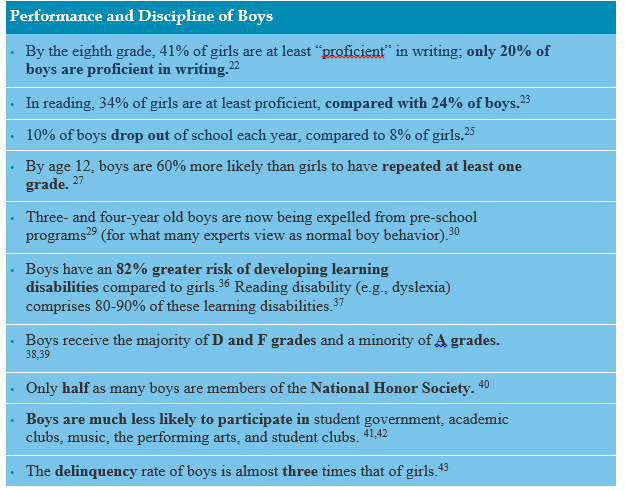
 Girls show significant gains in AP Course work. In 2016, females accounted for 56% of all students taking AP exams while boys accounted for 44%.96 When we look at the number of courses offered, females outnumber males in 26 of the 37 courses offered.
Girls show significant gains in AP Course work. In 2016, females accounted for 56% of all students taking AP exams while boys accounted for 44%.96 When we look at the number of courses offered, females outnumber males in 26 of the 37 courses offered.
Promoting and finding solutions for boys is not a prescription against girls. Promoting more boys into education professions and more girls into S.T.E.M. professions encourages opportunities for boys and girls to think about their roles in a changing economy and the type of careers they want to pursue. We must also develop career options in trades for those young men not interested in college.
B.1 Romeo and Juliet Saved My Life

Part C: The Social Consequences of the Under-Educated
Boys without a high school diploma have experienced a 38% decline in income over the last three decades.50 Why? In the past, boys who had not graduated high school could get jobs in manufacturing or agriculture, but in the last half century, the number of employees in manufacturing dropped from 27% of all jobs to 11%;51 the number in agriculture shrank from 15% of all jobs to less than 2%. The future looks worse: half of the new jobs will be professional occupations requiring a post-secondary education. The exceptions are largely low- pay service jobs.52
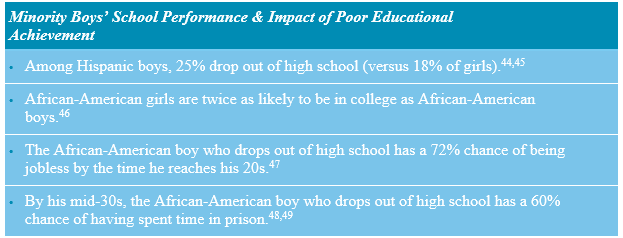
The data above impacts everything from our nation’s daughters53 to our nation’s debt. For example, when boys are interested in learning, they behave better in classrooms and thus are less likely to interrupt girls’ learning.54 When young men succeed, they are more attractive to women as husbands and future dads. When young women succeed, they can look at men as partners who will support their career endeavors or even take on traditional mom roles, such as caring for the children. Educated men and women provide families with more choices. Education allows mothers and fathers the opportunities to share the responsibilities of raising money and raising children, or some combination, rather than forcing one of them to raise money lest the children suffer.
The data suggests our national debt is impacted because less-successful boys are likely to become less-successful men who are less likely to pay taxes. Instead, they become unmarried dads55 whose children and their mothers are more likely to be supported by taxes others pay.
Our national debt only increases unless boys close their achievement deficits.56,57
Part D: Education and Gender
The K-12 system struggles to reach boys on many levels at a time when reading skills and bilingual skills are essential in a changing global economy. “Bilingualism from early ages can have wide ranging benefits, from cognitive and social advantages early in life, to long-term employment opportunities and competitiveness in the workplace.”97 Helping boys learn to read and appreciate language requires different approaches, particularly in the early years. This lack of attention leads to greater challenges later on.
These trends in reading have accelerated over the last several decades. We need to make changes that benefit girls and boys, and it’s harder to do so when gender equity reports operate from an outdated perspective.
We need to modify the way gender statistics are reported. The educational system has created a zero-sum game approach. When we compare boys and girls, we tend to do so solely from the perspective of how girls are performing or under-performing. Educational data is not used as effectively to implement policies and programs to help boys. S.T.E.M. (science, technology, engineering, and math) is a major push for girls in schools. We lack an equivalent incentive for boys in reading, language, and art. In a 2012 Gender Equity Report from the U.S. Department Education, the report began with the following paragraph:

 If one looks at the data from the full report, it’s clear boys are struggling far more in many areas. The educational needs and practices of 1972 are radically different from our 2018 needs. Yet we operate from an outdated perspective, and our educational data and its presentation of data reflects that reality. In order to serve the individual needs of all students, boys and girls equally, we must employ new practices that understands that boys learn differently than girls and that girls learn differently than boys. We must harness the energy of our boys and direct it in creative ways that empowers them rather than stifling them. We must look at the boy data, deal with it head on, and implement new practices that guide them to success. Consider trade-school options that allow boys, who may not prefer college, to pursue other well-paying careers or who may use their new skill to later fund a college education instead of leaning on government programs and loans.
If one looks at the data from the full report, it’s clear boys are struggling far more in many areas. The educational needs and practices of 1972 are radically different from our 2018 needs. Yet we operate from an outdated perspective, and our educational data and its presentation of data reflects that reality. In order to serve the individual needs of all students, boys and girls equally, we must employ new practices that understands that boys learn differently than girls and that girls learn differently than boys. We must harness the energy of our boys and direct it in creative ways that empowers them rather than stifling them. We must look at the boy data, deal with it head on, and implement new practices that guide them to success. Consider trade-school options that allow boys, who may not prefer college, to pursue other well-paying careers or who may use their new skill to later fund a college education instead of leaning on government programs and loans.
Part E: Finding Solutions
The U.S. has been a world leader in addressing girls’ needs58 and our nation now needs an increased presence in leading our boys. Over the last several decades, boys have struggled to find academic success. The solutions below provide some insight into the ways our K-12 can better prepare boys and girls for academic and life success.
 More male teachers. Many inner-city boys spend their early lives going from female-run homes to female-run elementary schools with mostly female teachers. Women account for 76% of all teachers at the elementary and secondary levels. At the elementary level, the numbers of male teachers are much lower. Men account for 9% of elementary school teachers. Without a positive male role model boys are vulnerable to being influenced by gangs’ false offers of a male identity. Especially in communities with high percentages of fatherlessness, schools have an opportunity to provide boys and girls with the best ways to find consistent positive leadership by:
More male teachers. Many inner-city boys spend their early lives going from female-run homes to female-run elementary schools with mostly female teachers. Women account for 76% of all teachers at the elementary and secondary levels. At the elementary level, the numbers of male teachers are much lower. Men account for 9% of elementary school teachers. Without a positive male role model boys are vulnerable to being influenced by gangs’ false offers of a male identity. Especially in communities with high percentages of fatherlessness, schools have an opportunity to provide boys and girls with the best ways to find consistent positive leadership by:
• Recruiting male teachers;
• Having male teachers certified to become “long-term teachers”—that is, teachers assigned to a boy (especially a fatherless boy) for multi-year periods;
• Bringing men into the classroom to talk about the importance of education.
• Having male teachers’ most positive values integrated into K-12 teacher training even as male teachers are learning about the positive values of female teachers
By supporting more male teachers, we break professional stereotypes and we offer male role models at a time when more are needed. Encouraging boys into teaching, nursing, and other currently female dominated professions is as important as promoting girls into S.T.E.M. (science, technology, engineering, and math). Additionally, higher divorce rates and the number of children born to unwed parents have left boys and girls with fewer male role models. In Father and Child Reunion, Dr. Warren Farrell documented the damage of father absence to children of both sexes.94 In Dr. John Gray and Dr. Warren Farrell’s upcoming book, The Boy Crisis*, we see the larger impact of uneducated boys who find gangs, violence, and unemployment instead of employment and contributions to schools and society. On many levels, we are failing them, but our schools have the power to redirect our sons. Boy-friendly Testing. Design tests that use methods of evaluating that are outgrowths of boys’ methods of learning (interactive, physically active, project-oriented, the incorporation of competitive games).
Updated teacher education. Updated teacher education. Identify and develop teacher trainings that would help boys and girls. For example, a study by the University of Missouri-Kansas City has codified practical strategies that work “to create boy-friendly classrooms that also help girls.”59 Teachers need to know which teaching styles, teacher characteristics, and programs have proven most effective for boys with varying challenges. We need to employ programs that are most effective in areas such as communication skill training and use creative ways to recruit male teachers.
• How can schools best establish mentoring and reading programs?
• How can cooperative ventures with the Boys’ Clubs and other boy-supportive organization be effective for boys and girls?
• If the findings prove valid that experience with the Boy Scouts increases performance in science, reading, and math, and goal-setting,60 then how can teachers learn from their methods?
Improved communication skills. The Achilles’ heel of humans is our inability to handle personal criticism without becoming defensive. The commerce of male adolescence—the trading of wit-covered put-downs—masks our sons’ pain with laughter. When they are put- down, they are further isolated. The resulting isolation is doubtless a contributor to boys’ increasing suicide rate in each year of adolescence and lack of interest in school.
We need to review the best existing school programs developing boys’ communication and listening skills prior to early adolescence, when boys’ raging sexual hormones and poor communication combine to leave boys feeling rejected and girls feeling objectified.
Various forms of active listening need to become as comfortable as a boys’ native language prior to adolescence. When boys increase their ability to listen and be heard by their peers, the security blanket provided by a listening-functional school such as Summit Prep (a Charter School in Redwood City, California that has a substantial percentage of students from disadvantaged backgrounds) can better emotional health even among boys coming from dysfunctional homes. Listening-functional schools must extend their training to parents so its students are not learning functional listening in school and dysfunctional listening at home.61
Boy-focused reading programs. When the U.S. discovered girls were doing worse in math and science, we re-examined everything in our math and science programs, from teachers’ styles to the degree to which math problems might be worded in more girl-friendly ways. The province of Ontario, Canada is beginning to do that for boys: developing a special reading program for boys due to boys’ special challenges with reading.62 In the U.S., a Guys Read program in Alaska features men reading funny, boy-friendly books to fourth grade boys during the lunch hour. The result? Boys otherwise known for behavior problems were writing their own children’s books and competing to read them and bragging about them.63 Interactive video games that require reading skills to win are another boy-friendly approach. Outcome studies of these programs should be conducted so the most effective of them can be expanded to the communities that most need them.
Spread the lessons of charter schools: A number of charter schools are working to close gender gaps and black/white achievement gaps. Examples include the Promise Academy Charter Schools in Harlem64 and the Eagle Academy, an early-childhood school in Washington DC.65 Reviewing evaluations of school systems like those in Milwaukee and Washington, D.C. that offer school choice is important.66 When findings are reported, such as those of the school choice program in Milwaukee for disadvantaged families, (that with half the per-student public funding there is more than a 50% higher graduation rate than in even more-advantaged public schools in Milwaukee,67) we could see if those findings are accurate and applicable to schools in other cities.
Single-Sex Education: Under what conditions—and with which children during which developmental stages—does single-sex and mixed-sex education work? Hundreds of public schools now use single-sex classrooms.68 In public education, the most popular application of this option is gender-separate core classes (math, science, and language arts) in combination with other classes being gender-integrated.69 Three key populations have shown improvement: girls in math and science, boys in behavioral areas, and boys in core classes. A recent study by Fryer and Levitt found that girls do not lag behind boys in math in countries with same-sex schooling.70 The goal is to investigate what creates win-win education environments for both sexes, and under what conditions.
Drugs-as-Baby Sitter vs. Drugs When All Else Fails: We need to examine the most-likely-to- succeed options prior to prescribing Ritalin and other drugs on our sons: diet; interactive games; physical activities; projects involving building or doing; mentorship; same-sex classrooms; male teachers; training teachers in boys’ psychosocial development.
Developing Evidence-Based Practices: Use research from entities such as the University of Pennsylvania’s Center for the Study of Boys’ and Girls’ Lives,71 which assesses the best educational practices, and create hybrid school/home/community projects such as the one coordinated by the Even Start Family Literacy Program in Prince George’s County, Maryland.72
Part F: Essential Readings for Educators & Policy Makers
Leading experts across the country have documented the challenges our boys now face and offer solutions for ways to create environments that help boys and girls. The books listed below are essential reads for anyone involved in education. They provide formative understandings of the ways boys and girls learn through approaches that embrace nature, nurture, and culture. Boys and girls succeed when we understand their differences and join in common purpose to build our schools, families, and communities to reach every child’s needs.
Recommended Readings for Policy Makers and Educators
• The Boy Crisis: Why Our Boys Are Struggling And What Can Be Done About It by Farrell, Warren, Ph.D, Gray, John, Ph.D.
• Saving Our Sons: A New Pathway for Raising Healthy and Resilient Boys by Michael Gurian
• The Wonder of Boys: What Parents, Mentors, and Teachers Can Do to Shape Boys into Exceptional Men by Michael Gurian
• The Wonder of Girls: Understanding the Hidden Nature of Our Daughters by Michael Gurian
• Why Gender Matters, Second Edition: What Parents and Teachers Need to Know About the Emerging Science of Sex Differences by Leonard Sax
• Boys Adrift: The Five Factors Driving the Growing Epidemic of Unmotivated Boys and Underachieving Young Men by Leonard Sax
• The Minds of Boys: Saving Our Sons from Falling Behind in School and Life by Michael Gurian and Kathy Stevens.
• The Trouble with Boys: A Surprising Report Card on Our Sons, Their Problems at School, and What Parents and Educators Must Do by Peg Trey
• Raising Cain: Protecting the Emotional Lives of Boys by Michael Thompson
• Writing the Playbook: A Practitioner’s Guide to Creating a Boy-Friendly School by Kelly King
Part G: End Notes
Contact
Contact WHCBM Steering Committee:
Coalition Chair: Dr. Warren Farrell - warren@warrenfarrell.com
Please Donate!
Your donations to the work of the Coalition to Create a White House Council on Boys and Men through PayPal and Network for Good are processed by our parent 501(c)(3) non-profit association, the Global Initiative for Boys and Men.
Paypal:
You can also become a Patron through Patreon.
Become a Patron!
Sign up for our newsletter, The Proposal.

